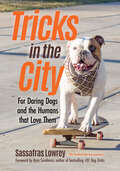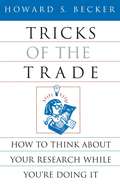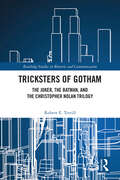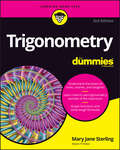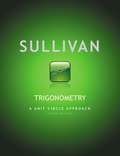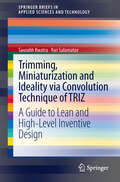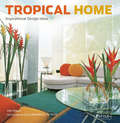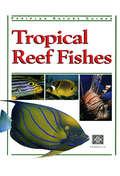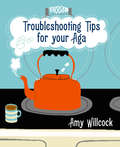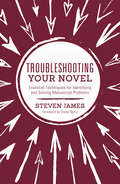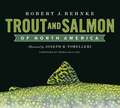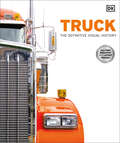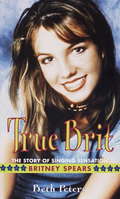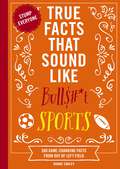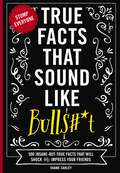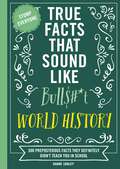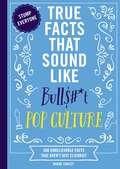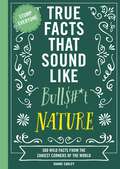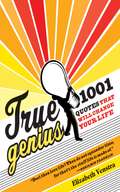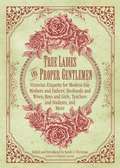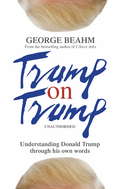- Table View
- List View
Triaging the Streaming Wars (Electronic Media Research Series)
by Robert Alan Brookey Jason Phillips Timothy PollardThis volume considers the different implications of the rise of streaming services and their particular acceleration during the COVID-19 pandemic. Exploring the significant disruption caused to the entertainment industries by the rise of these streaming services, a team of international scholars examine changes to labor issues and compensation, which were central to the conflict between the Writers Guild of America members and their agents, the broadening divide between networks and affiliates, the significant consolidation of the media industry resulting from Disney’s acquisition of Fox ahead of the launch of Disney+, and the variety of business models behind these services that defy the traditional advertising models and standard revenue streams. This thorough and multifaceted look at this rapidly growing section of the entertainment industry will be of interest to academics and students working in film and TV studies, media industry studies, digital media studies, business, and communication studies.
Triaging the Streaming Wars (Electronic Media Research Series)
by Robert Alan Brookey Jason Phillips Timothy PollardThis volume considers the different implications of the rise of streaming services and their particular acceleration during the COVID-19 pandemic. Exploring the significant disruption caused to the entertainment industries by the rise of these streaming services, a team of international scholars examine changes to labor issues and compensation, which were central to the conflict between the Writers Guild of America members and their agents, the broadening divide between networks and affiliates, the significant consolidation of the media industry resulting from Disney’s acquisition of Fox ahead of the launch of Disney+, and the variety of business models behind these services that defy the traditional advertising models and standard revenue streams. This thorough and multifaceted look at this rapidly growing section of the entertainment industry will be of interest to academics and students working in film and TV studies, media industry studies, digital media studies, business, and communication studies.
Tricks in the City: For Daring Dogs and the Humans that Love Them
by Sassafras Lowrey#1 New Release in Animals - Yes! You Can Teach an Old Dog New TricksA fun and unique dog training book by Sassafras Lowrey – 2019 Do More With Your Dog! All Star Trainer of the Year.Your dog can become a star. Go beyond basic dog training and discover your puppy’s hidden talents. Tricks in the City provides step-by-step training instructions to help you teach your dog tricks, from basic to advanced.Learn from a Certified Trick Dog Instructor. Sassafras Lowrey is a celebrated author and Certified Trick Dog Instructor (CTDI). She has trained and competed in sports from dog agility and rally obedience to canine parkour and tricks. Her writings include viral content on Dogster.com and articles in The Bark magazine, Dogster Magazine, and Whole Dog Journal.Ever wish your dog could be like the dogs you see on TV? Now your dog can! From skateboarding and playing basketball or piano to finding hidden objects, you can have fun with your dog and transform your relationship. Tricks in the City specifically focuses on tricks that can be done safely in small spaces, city streets, and parks. Dog tricks are a great way to bond with your dog, build your dog’s physical and mental strength, and impress your friends and family.You will learn:How to build better relationships with your dog through trick trainingHow to teach puppies and old dogs new tricksThe positive physical, mental, and emotional health impacts of trick training for dogsTricks in the City includes an interview with America's Got Talent star Sara Carson and a foreword by Kyra Sundance, founder of Do More With Your Dog! If you have read Zak George's Dog Training Revolution, Lucky Dog Lessons, or 101 Dog Tricks, you will love Tricks in the City.
Tricks of the Trade: How to Think about Your Research While You're Doing It (Chicago Guides To Writing, Editing, And Ser.)
by Howard S. BeckerDrawing on more than four decades of experience as a researcher and teacher, Howard Becker now brings to students and researchers the many valuable techniques he has learned. Tricks of the Trade will help students learn how to think about research projects. Assisted by Becker's sage advice, students can make better sense of their research and simultaneously generate fresh ideas on where to look next for new data. The tricks cover four broad areas of social science: the creation of the "imagery" to guide research; methods of "sampling" to generate maximum variety in the data; the development of "concepts" to organize findings; and the use of "logical" methods to explore systematically the implications of what is found. Becker's advice ranges from simple tricks such as changing an interview question from "Why?" to "How?" (as a way of getting people to talk without asking for a justification) to more technical tricks such as how to manipulate truth tables. Becker has extracted these tricks from a variety of fields such as art history, anthropology, sociology, literature, and philosophy; and his dazzling variety of references ranges from James Agee to Ludwig Wittgenstein. Becker finds the common principles that lie behind good social science work, principles that apply to both quantitative and qualitative research. He offers practical advice, ideas students can apply to their data with the confidence that they will return with something they hadn't thought of before. Like Writing for Social Scientists, Tricks of the Trade will bring aid and comfort to generations of students. Written in the informal, accessible style for which Becker is known, this book will be an essential resource for students in a wide variety of fields. "An instant classic. . . . Becker's stories and reflections make a great book, one that will find its way into the hands of a great many social scientists, and as with everything he writes, it is lively and accessible, a joy to read."—Charles Ragin, Northwestern University
Tricksters of Gotham: The Joker, The Batman, and The Christopher Nolan Trilogy (Routledge Studies in Rhetoric and Communication)
by Robert E. TerrillTricksters of Gotham explores the "trickster" tale through an in-depth look at Christopher Nolan’s Batman trilogy: Batman Begins, The Dark Knight, and The Dark Knight Rises.The trickster figure is an ancient and variable figure, versions of which populate the myths and folklore of many human cultures worldwide. Conceptualising the trilogy as a single aggregate text with a clear narrative arc, the author explores the variety of trickster figures present in the films and draws clear parallels with the surrounding social and political context. Departing from the central argument that the Batman trilogy shows a variety of trickster characters, even Batman himself, this book shows contemporary trickster figures to be rich and relevant cultural resources that can focus our attention on those elements of the social order that have become too rigid, hierarchical, or exclusionary. The author argues that they can model tactics for engaging with tricksters when they inevitably arise in civic culture, offering insights about how to manage interactions with these figures who can be both productively disruptive and potentially destructive. This book pays close attention to the characters portrayed in the Nolan Batman trilogy—not only the Batman and the Joker but the more minor characters as well—to discover what trickster-like tactics they may offer. In this way, the book intends to render these films as a sort of equipment for civic life and to encourage similar analyses of other contemporary cultural artifacts.Through close readings of these films, the book renders the Nolan Batman trilogy as what rhetorical theorist Kenneth Burke refers to as “equipment for living.” This book will interest scholars and students of rhetoric and public culture, film studies, and communication.
Trigger Point Therapy with the Foam Roller: Exercises for Muscle Massage, Myofascial Release, Injury Prevention and Physical Rehab
by Chris Knopf Dr. Karl KnopfUnlock the healing powers of trigger-point foam rolling with easy-to-follow exercises anyone can do at home and in the gym. Deceptively simple and incredibly versatile, the trigger point foam roller is a highly effective self-therapy tool. By following the step-by-step movements in this book, you can maximize its healing potential to: Alleviate Pain Speed Recovery Release Tension Break Up Knots Rehabilitate Injuries Increase Flexibility A complete guide to using this amazing piece of equipment for self-treatment, Trigger Point Therapy with the Foam Roller shows how to soothe, relieve and heal the tight muscles caused by everything from hours sitting at a desk to overdoing it at the gym. It also details the best methods to release painful trigger points and break up soft-tissue adhesions that contribute to chronic pain.
Trigonometry For Dummies
by Mary Jane SterlingMake trigonometry as easy as 1-2-3 Believe it or not, trigonometry is easier than it looks! With the right help, you can breeze through your next trig class, test, or exam and be ready for your next math challenge. In Trigonometry For Dummies, you’ll learn to understand the basics of sines, cosines, and tangents, graph functions, solve tough formulas, and even discover how to use trig outside the classroom in some cool and interesting ways. Ditch the confusing jargon and take a plain-English tour of one of the most useful disciplines in math. In this lifesaving guide, you’ll learn how to: Graph trig functions, including sine, cosine, tangent, and cotangent functions Understand inverse trig functions and solve trig equations Relate triangles to circular functions and get a handle on basic identitiesSo, whether you’re looking for an easy-to-use study guide, to boost your math grade, or get a refresher on some basic trig concepts after a long absence from studying, Trigonometry For Dummies is your ticket to understanding the mathematical mysteries of the triangle.
Trigonometry: A Unit Circle Approach (9th Edition)
by Michael SullivanMike Sullivan’s time-tested approach focuses students on the fundamental skills they need for the course: preparing for class, practicing with homework, and reviewing the concepts. In the Ninth Edition, Trigonometry: A Unit Circle Approach has evolved to meet today’s course needs, building on these hallmarks by integrating projects and other interactive learning tools for use in the classroom or online.
Trimming, Miniaturization and Ideality via Convolution Technique of TRIZ
by Saurabh Kwatra Yuri SalamatovThe book is a valuable research tool-kit for innovators, amateur & professionals alike. Additionally, College & University faculties on Engineering, who organize yearly workshops internationally will find hundreds of novel themes to choose from. Some teachers might just secretly buy this book to introduce out-of-box brain-teasers in classroom to add fizz to normal (at times boring) lecturing. The book can be used as main/add-on textbook towards following courses: (1) Master's degree programs on design innovation worldwide and (2) Senior undergraduate courses in industrial, engineering & product design.
Tropical Birds of Southeast Asia
by Morten StrangeThis handy field guide is an excellent introduction to the fantastic array of birds found in Southeast Asia. This selection features 96 typical species and clearly describes their special characteristics. Many are easy-to-find birds adapted to living around cities and towns, while others can be seen in nature reserves. Illustrated with over 100 beautiful color photographs, showing the birds in their natural habitats, this book will delight both keen bird watchers and beginners alike. Over 100 full-color photographs Informative text Scientific and common names listed
Tropical Home: Inspirational Design Ideas
by Luca Invernizzi Tettoni Kim InglisThis Asian interior design and architecture book showcases the best luxury homes and interior spaces of the Pacific region.Asia has emerged in the last couple of decades as the global leader in tropical villa design. <P><P>With innovative indoor/outdoor architecture engineered to facilitate relaxed, al fresco lifestyles, there are myriad solutions to suit every taste and pocket. Featuring hundreds of homes, garden estates, hotels, restaurants and more from India to Indochina, Indonesia to Sri Lanka, the design book gives a tantalizing glimpse of the latest trends for tropical wannabe decorators.Full-color photography of interiors and exteriors, garden features, pools and pavilions, as well as decorative details and fashion forward furniture, is accompanied by insightful text that traces past history and present trends, and predicts what is to come, design wise, in the future.
Tropical Reef Fishes
by Gerald AllenThis Periplus Nature Guide provides an excellent introduction to 68 of the most commonly encountered tropical reef fishes. Written by Dr. Gerald Allen, international authority on reef fishes, it features stunning color shots by some of the world's best underwater photographers.
Troubleshooting Tips for Your Aga
by Amy WillcockMore people than ever before are discovering the joys of the Aga. It's so much more than just a cooker - it's a style statement and a way of life. But Agas are notoriously tricky to master, and where do you turn to with those niggling questions like, what do you cook where, how do you control heat loss, and how do you bake the perfect cake? Now in Troubleshooting Tips for your Aga, renowned Aga cook and expert Amy Willcock brings you the answers to all these questions and many more. From advice on temperature and timings, to vital cooking equipment, to cleaninig and servicing, and even using your Aga for more than just cooking, this is the top tips book for every Aga owner.Amy also answers the most Frequently Asked Questions about Agas, with a general troubleshooting guide to cover every eventuality. You'll wonder how you managed without it!
Troubleshooting Your Novel: Essential Techniques for Identifying and Solving Manuscript Problems
by Steve Berry Steven JamesTake your story to the next level of excellence! You've completed the first draft of your novel--now what? Chances are, it's not perfect...at least not yet. In order to increase your chances of getting a literary agent, selling your manuscript to a publisher, or garnering an audience for your self-published work, you need targeted, practical instruction on tackling the problem areas and weak spots in your story. You need Troubleshooting Your Novel. In this hand-on, easy-to-use guide, award-winning author Steven James provides helpful techniques and checklists, timesaving tricks of the trade, and hundreds of questions for manuscript analysis and revision. You'll learn how to:ADJUST elements of story progression, from causality, tension, and setbacks to plot twists, climaxes, and endings.DEVELOP authentic, riveting characters by exploring their attitudes, desires, beliefs, and more.LEARN narrative techniques for elements such as dialogue, flashbacks, suspense, voice, subtext, and flow.ENSURE reader engagement by aligning with their expectations, fulfilling promises, and instilling trust.CHECK issues with context and continuity.You owe your book more than just a polish and a proofread. Strengthen your story, prepare it for the marketplace, and make it the best it can be with Troubleshooting Your Novel.
Trout and Salmon of North America
by Thomas Mcguane Joe Tomelleri Robert BehnkeThis beautiful and definitive guide brings together the world's lead leading expert on North American trout and salmon, Robert Behnke, and the foremost illustrator in the field, Joseph Tomelleri. North America is graced with the greatest diversity of trout and salmon on earth. From tiny brook trout in mountain streams of the Northeast, to cutthroat trout in the rivers of the Rockies, to Chinook salmon of the Pacific, the continent is home to more than 70 types of trout and salmon. How this came to be, how they are related, and what makes them unique -- and so breathtaking -- is the story of Trout and Salmon of North America. The more than 100 illustrations of trout and salmon by Joseph Tomelleri showcased here exhibit a genius for detail, coloration, and proportion. Each portrait is made from field notes, streamside observations, photographs, and specimens collected by the artist. The result is a set of the most accurate and stunning illustrations of fish ever created. Robert Behnke has distilled 50 years of his research and writing about trout and salmon in completing this book. No one understands better than Behnke the diversity and conservation issues concerning these fishes or communicates so lucidly the biological wonders and complexities of their particular beauty. Also included are more than 40 richly detailed maps that clearly show the ranges of populations of trout and salmon throughout North America. An irresistible delight for anyone who appreciates natural history, Trout and Salmon of North America is a master guide to the natural elegance of our native fishes.
Truck: The Definitive Visual History (DK Definitive Visual Histories)
by DKA lavishly illustrated celebration of trucks and trucking, from the first motorized wagons to the advent of electric, driverless freight vehicles.Charting decade after decade of innovation and change, The Truck Book is a beautifully illustrated history of trucks, trucking culture, and the romance of the open road.Trucks, semis, and vans share their origins in the steam wagons of the 1800s and the invention of the modern combustion engine in the 1870s. As steam power gave way to gas and diesel engines, trucks evolved and diversified according to their desired purpose - becoming everything from panel vans and pickup trucks to heavy goods vehicles (HGVs), or construction trucks, such as log carriers or concrete transporters. Military forces worldwide soon realized the value in these vehicles, and so they played a defining role in the wars of the 20th century. In the meantime, they have also saved lives as ambulances and fire trucks and entertained the masses in the form of monster trucks. The Truck Book showcases the most important and iconic makes and models of every era - from the Ford TT to the Bedford TM Turbo 92 Series, to the Toyota Hilux. Along the way, it evokes the freedom and nostalgia of the open road, explores trucking culture, and shows how trucks and trucking companies, such as Mack and UPS, have won a place in fans' hearts. Weaving together stunning photographic catalogs with specially commissioned "visual tours," feature spreads on truck models, designers, and manufacturers, as well as on milestone events or technological developments over the last 200 years, The Truck Book is the most comprehensive and best-illustrated title available on the subject.
True Brit
by Beth PetersPOP PRINCESS Britney Spears is putting girls back on the map in the pop music world. With the effervescent and intoxicating sounds of her first album, . . . Baby One More Time, Britney shot straight to the top of the charts--in just the first week of the album's release. Her ripe style and smart lyrics have captured the hearts of millions of fans, young and old. But Britney didn't just come out of nowhere: she is a multitalented entertainment sensation who can't remember a time in her life when she wasn't singing, acting, or dancing. She broke into the biz at the tender age of eight, and it wasn't long before she made her mark. TRUE BRIT gives you all the backstage info, from her first audition for The New Mickey Mouse Club to her exciting decision to go solo. You'll also find out what it was like for Brit to work with the boys of 'N Sync, the rumors of romance, and her dazzling life beyond the stage. Britney is more than just a singer--she's a performing phenomenon. And TRUE BRIT is your ticket into her amazing world.
True Facts That Sound Like Bull$#*t: 500 Game-Changing Facts from Out of Left Field
by Shane CarleyProve you are the smartest person in the room with 500 true trivia facts about sports. These facts are so absurd some might even say that they sound like bull$#*t! Explore the slam dunks and the Olympic Golds in this fun addition to the True Facts series that shares all things sports. Give the gift that keeps giving to friends, family, fathers, or grads and test your knowledge.Knowledge is power! Grab your team, put on your game face, and crush the competition at trivia night with True Facts That Sound Like Bull$#*t: Sports! This book isn't just a game-changer; it's a game-winner, packed with 500 jaw-dropping facts that will make you question the very fabric of sports reality. Including facts like:The sport of wife-carrying originated in Finland and has since become an international competition, challenging couples to navigate obstacle courses with the husband carrying the wife on his back.Michael Jordan and Scottie Pippen once had a pancake cook-off to see who made them better.The ancient Greeks, founders of the Olympics, competed in the nude, giving new meaning to the term "gymnasium," derived from the Greek word "gymnos," meaning naked.The sport of table tennis evolved from a Victorian parlor game known as "whiff-whaff," enjoyed as a post-dinner entertainment by the upper class in 19th-century England.The first game of basketball was played with a soccer ball and two peach baskets as goals, resulting in a final score of 1-0.From the wacky to the downright unbelievable, these sports facts will have you exclaiming "No way!" Gather your fellow sports enthusiasts, dive into the pages of this factual treasure trove, and emerge as the undisputed champion of the ultimate sports trivia showdown!
True Facts That Sound Like Bull$#*t: 500 Insane-But-True Facts That Will Shock and Impress Your Friends (Mind-Blowing True Facts)
by Shane CarleyProve you are the smartest schmuck in the room with 500 true trivia facts that sound absurd. These facts are so absurd some might even say that they sound like bull$#*t!Knowledge is power! Crush the competition at trivia night, or start the most interesting conversation ever with real facts that are hard to believe. This book is loaded with mind-blowing facts that are sure to keep you wondering, "How are these even true?" while equipping you to outsmart everyone around and blow their minds. Topics include:ScienceAmerican SportsHistoryPop CultureNaturePut your game face on, and prove once and for all that you are the real know-it-all! Gather your friends and family 'round and get ready to learn some wild and crazy trivia and facts such as:True or False? A chicken once survived almost two years after having its head cut off.True or False? The dog that played Toto in The Wizard of Oz was paid a salary.How many baseballs does the MLB use every season?What state has jousting as its official sport?True or False? Most Canadians live south of Seattle.Stump everyone with True Facts That Sound Like Bull$#*t!
True Facts That Sound Like Bull$#*t: 500 Preposterous Facts They Definitely Didn’t Teach You in School
by Shane CarleyProve you are the smartest person in the room with 500 true trivia facts about world history. These facts are so absurd some might even say that they sound like bull$#*t! Explore the wild and the wacky or history in this fun addition to the True Facts series that shares all things from all over the globe. Give the gift that keeps giving to friends, family, fathers, or grads and test your knowledge.Knowledge is power! Crush the competition at trivia night or start the most interesting conversation ever with real facts that are hard to believe. This book is loaded with mind-blowing facts that are sure to keep you wondering, "How are these even true?" while equipping you to outsmart everyone in the room. Including:Turkeys were once worshipped as gods by the Mayans.Forks were seen as sacrilegious in 11th century Italy.Pope Gregory IV once declared a war on cats.President Abraham Lincoln is in the Wrestling Hall of Fame.The longest war in history lasted from 1651 to 1986, between the Netherlands and the Isles of Scilly. There were no casualties.Put your game face on and prove once and for all that you are the real history know-it-all! Gather your friends and family 'round and get ready to learn some crazy trivia they definitely didn&’t teach you in history class.
True Facts That Sound Like Bull$#*t: 500 Unbelievable Facts That Aren’t Just Clickbait
by Shane CarleyProve you are the most cultured person in the room with 500 true trivia facts about pop culture. These facts are so absurd some might even say that they sound like bull$#*t! Explore the scandalous and the secretive in this all access addition to the True Facts series that spills all the gossip of your favorite celebrities, movies, music, and more. Give the gift that keeps giving to friends, family, fathers, or grads and test your knowledgeKnowledge is power! Crush the competition at trivia night or start the most interesting conversation ever with real facts that are hard to believe. This astonishing collection of facts is so wild and unexpected, it seems like pure fiction. True Facts That Sound Like Bull$#*t: Pop Culture is your all-access pass to uncovering the craziest stories, facts, and trivia about your favorite celebrities, movies, music, and more. From the unthinkable behind-the-scenes tales of Hollywood to the most surprising celebrity quirks, this compendium dives deep into the heart of pop culture&’s most bewildering mysteries and phenomena. Whether you&’re a pop culture aficionado, a trivia enthusiast, or simply in search of a good laugh, this book is an essential addition to your collection.Inside you&’ll discover facts such as:The iconic scream of the TIE fighters in Star Wars was actually made by combining an elephant's call with car tire screeches on wet pavement.Before hitting it big, Elvis Presley was a truck driver, and Jim Carrey once worked as a janitor.The famous "I'll be back" line from The Terminator was almost "I will return."Michael Jackson attempted to buy Marvel Comics in the 1990s because he wanted to play Spider-Man in his own produced movie.The first YouTube video was uploaded by co-founder Jawed Karim, featuring him at the San Diego Zoo and titled "Me at the zoo."Strap in for an exhilarating ride through the wildest, most peculiar, and unbelievably true corners of pop culture. Your view of the entertainment world will never be the same!
True Facts That Sound Like Bull$#*t: 500 Wild Facts from the Zaniest Corners of the World
by Shane CarleyProve you are the smartest person in the room with 500 true trivia facts about nature, plants, and animals. These facts are so absurd some might even say that they sound like bull$#*t! Explore the wild and the wacky in this fun addition to the True Facts series that shares all things flora and fauna. Give the gift that keeps giving to friends, family, fathers, or grads and test your knowledge.Say hello to the astonishing natural world with this mind-boggling collection of downright unbelievable facts that will have you doing double-takes at every turn. This captivating compendium is your ticket to exploring the wackiest secrets Mother Nature has up her sleeve. From the outrageous mating rituals of exotic creatures to the perplexing phenomena of Earth's wildest landscapes, True Facts That Sound Like Bull$#*t: Nature covers a vast array of topics that will leave you questioning everything you thought you knew about our planet. Each fact has been researched and verified, ensuring that even the most skeptical readers will be left in awe. Perfect for trivia night, nature enthusiasts, and anyone who loves a good laugh, this engaging and entertaining book is an incredible addition to your library. Topics include:AnimalsPlants & FungiThe Watery WorldHuman Anatomy & BiologyThe Natural WorldPut your game face on and prove once and for all that you are the real know-it-all! Gather your friends and family 'round and get ready to learn some wild and crazy trivia and facts such as:True or False? Mosquitoes have a preference for certain blood types.True or False? Caring for houseplants has been shown to make humans more stressed.Did you know: Fish don't have eyelids, but the giant guitarfish can protect its eyes by retracting its eyeballs nearly 2 inches (5 centimeters) inside its head.True or False? The average adult human has more than 60,000 miles of blood vessels inside their body.Believe it or not: All tea comes from the Camellia sinensis plant.Buckle up and prepare for a wild ride through the most fascinating, outlandish, and utterly mind-blowing corners of the natural world. You'll never look at nature the same way again!
True Genius: 1001 Quotes That Will Change Your Life
by Elizabeth VenstraThe earliest form of the word "genius" referred to a person who powerfully influenced the character, conduct, or fortunes of another. Times have changed and with them the various connotations of the word "genius," but today we still look to the more enlightened members of our society to elevate the rest of us. True Genius is a compendium of 1,001 moving quotes from the world's geniuses of the past and present whose words will leave an indelible mark on your life. Selected from the output of the greatest minds in literature, history, philosophy, philanthropy, and art-and divided into categories such as love, life, and forgiveness-these words of wisdom are sure to inspire the positive change and mental improvement necessary for your own quest to achieve true genius.
True Ladies and Proper Gentlemen: Victorian Etiquette for Modern-Day Mothers and Fathers, Husbands and Wives, Boys and Girls, Teachers and Students, and More
by Sarah A. ChrismanRegardless of time period, some things hold true: kindness is timeless. Invasion of privacy; divorce; relationship issues; encounters between people from different places and cultures; new technologies developed at dizzying speeds . . . the hectic pace of life in the late nineteenth century could make the mind reel. Wait a minute--the nineteenth century? Many of the issues people faced in the 1880s and ’90s surprisingly remain problems in today’s modern world, so why not take a peek at some Victorian advice about negotiating life’s dizzying twists and turns? Gathered from period magazines and Hill’s Manual of Social and Business Forms, a book on social conduct originally published in 1891, this volume provides timeless guidance for a myriad of situations, including: The husband’s duty: Give your wife every advantage that it is possible to bestow. Suggestions about shopping: Purchasers should, as far as possible, patronize the merchants of their own town. (Buy local!) Suggestions for travel: Having paid for one ticket, you are entitled to only one seat. It shows selfishness to deposit a large amount of baggage in the surrounding seats and occupy three or four. Unclassified laws of etiquette: Never leave home with unkind words. This advice is accompanied by watercolors and illustrations throughout. Though these are tips originate from nineteenth-century ideas, you’ll find that they certainly do still apply.
Trump on Trump
by George BeahmOne thing you cannot deny about Donald Trump is that he speaks his mind... and the results are fascinating!Get to know how that mind works by reading his words. This is an unbiased collection of Trump's most famous and interesting quotes and thus an unofficial guide to his thinking.Brash, outspoken and successful, Donald Trump is a political phenomenon. Some of his more contentious comments have outraged the immigrant community, feminist groups and even the Pope. Whether you like him or loathe him, he's impossible to ignore.Now you can understand more about this most infamous public figure and form your own opinion about the way he thinks. Covering the time since Trump announced that he was running for Republican candidacy, this book looks at excerpts and speeches and puts them into context. Among many topics it covers his views on business, America and other countries; his opinion of himself, women and those who stand, or have stood, against him.This is a fascinating insight into the world's most controversial politician.

